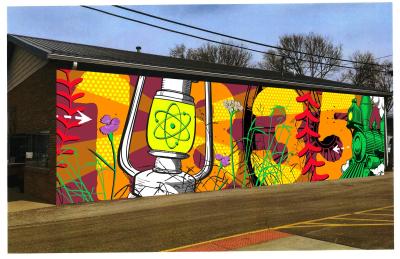
Union Street Beacon
By Fatherless
Fall 2023
South side of 209 N. Union St.
Mural sponsors:
City of Byron
Orthopedic Rehab Specialists Physical Therapy
Constellation Byron Generating Station
Fehr Graham Engineering & Environmental
Byron Bank
Convey All Pumping & Conveying
Custom Concrete Construction
Generations at Neighbors
Loomis International
Sterling Federal Bank
Weezy’s Sports Bar & Grill
With special thanks to:
Mayor John Rickard
Byron City Council and Staff
Painters Local Union 607
JR Horwedel
Nova Painting & Decorating, Jennifer Bunjes
Easy Care Paints
About the Artists:
Fatherless is a print collective from Rockford IL that started in 2010. They have gained international attention with their print, installation and commission work using a colorful palette and bold graphics. The members operate as a unit, collaborating freely with each other’s ideas and imagery. This process does not reveal any individual artist or “father” but rather an amalgam of the whole. The artists are Javier Jiminez, Greg Lang, Dave Menard and Ben Rider.
About the mural:
The focus of Union Street Beacon is the lantern, a symbol of hope, goodness and energy that goes outward, but also something signifying a destination and inclusiveness. It is also representative of both the underground railroad and Byron Generating Station.
Looking closely, the viewer discovers many other references to past and present Byron!
Underground Railroad - The Lucius Read house was one of the first brick structures built in Byron in the early 1840s and quickly became a focal point of activity in the young community. Information indicates that the Read family was active in the anti-slavery movement and that they provided a safe haven for runaway slaves being smuggled north through the Underground Railroad. When runaway slaves arrived in Byron, they were hidden in one of three safe houses. The Read House is the only one still in existence today. From Byron they would travel either north toward Wisconsin or go east toward Chicago.
Constellation - Byron Generating Station - With iconic twin cooling towers overlooking the Rock River Valley, Byron Generating Station's two nuclear reactors can produce up to 2,347 megawatts (MW) of zero-emissions energy; enough carbon-free electricity to power the equivalent of more than 1.7 million homes.
1835 – In July 1835, Jared W. Sanford traveled through the unsettled Rock River on his way from Dixon’s Ferry (Dixon) to Midway (Rockford) where his brother Joseph was then employed. Impressed by this region with its rich soil, abundant water, and plentiful lumber, he paused long enough to place a claim stake. Soon, he, his brother Jared, and friend Peter Norton returned to lay the foundations for two cabins. The pioneers who came to this area in 1835 believed the settlement they founded along the banks of the Rock River would one day become a prosperous town, rich in farmland and thriving local businesses.
Train Locomotive - In 1910, Byron was bustling with activity, including the coming and going of trains. Train whistles tooted, great steam engines shot plumes of smoke into the air, and passenger and freight trains moved to and from the depots. Two railroads passed through Byron in those days: the Milwaukee Road and the Chicago Great Western. Railroads were a popular way to travel back then for both goods and people. Local farmers used trains to move grain and livestock while local businesses could sell the latest fashions and goods from all over the world right here in Byron. Byron residents also used the railroad to visit relatives or friends in Chicago and other communities nearby.
Red baseball stitching - Albert Goodwill Spalding, professional baseball player and famous sporting goods manufacturing founder, was born right here in Byron in 1850. While living in Rockford, Albert met Civil War veterans who had learned a game called baseball. In a short time, Albert began playing the game and soon discovered he was quite good at it. He played for the Boston Red Stockings and, in 1875, the Chicago White Stockings (present Chicago Cubs) opened negotiations to secure Spalding from Boston. As a result, he became the manager, captain and pitcher for the White Stockings in 1876. Following the 1877 season, he retired as a player to devote time to his business enterprise, A.G. Spalding and Brothers Sporting Goods Company, where they began supplying balls and equipment to baseball teams and soon branched out into other sports. He continued as manager through the 1878 season, and became president of the Chicago Cubs in 1882, a position he held until his retirement in 1891. In 1939, Albert Spalding was inducted into the National Baseball Hall of Fame.
Stagecoach Wheel – Byron was situated along the Galena-Chicago Stagecoach Trail and was likely an official stop given its river crossing and since the next known stop to the west was 40 miles away. Byron was also a stop on the stagecoach line between Dixon’s Ferry and Midway, which allowed for twice a day mail delivery as opposed to once a week.
Prairie Grass - The Jarrett Prairie Nature Preserve is the best-known preserve in the Byron Forest Preserve District. These rolling hills of tallgrass prairie, hill prairies, oak savannas, and oak woodlands have been an Illinois Nature Preserve since 1992. The Byron Forest Preserve District was founded in 1980 to protect the rare prairie remnants that were discovered at this site in 1978. This preserve is home to hundreds of native plant and animal species and several endangered species.
For more information regarding the history of Byron, please plan a visit to the Byron Museum of History and Lucius Read House, located at 110 N. Union St. in Byron, or visit www.byronmuseum.org. For more information regarding the Byron Forest Preserve, visit www.byronforestpreserve.com.
